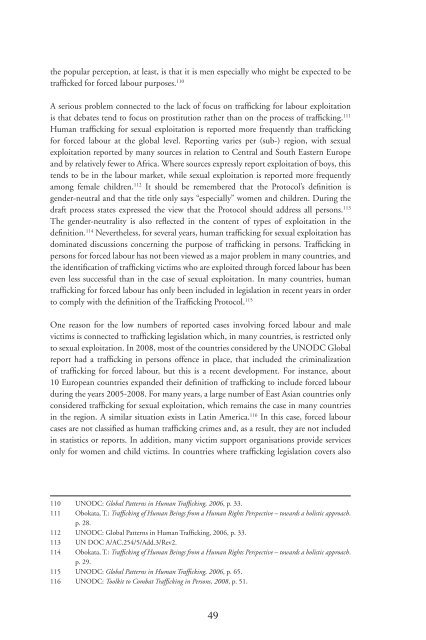Trafficking in human beings: human rights and ... - unesdoc - Unesco
Trafficking in human beings: human rights and ... - unesdoc - Unesco
Trafficking in human beings: human rights and ... - unesdoc - Unesco
Create successful ePaper yourself
Turn your PDF publications into a flip-book with our unique Google optimized e-Paper software.
the popular perception, at least, is that it is men especially who might be expected to be<br />
traffi cked for forced labour purposes. 110<br />
A serious problem connected to the lack of focus on traffi ck<strong>in</strong>g for labour exploitation<br />
is that debates tend to focus on prostitution rather than on the process of traffi ck<strong>in</strong>g. 111<br />
Human traffi ck<strong>in</strong>g for sexual exploitation is reported more frequently than traffi ck<strong>in</strong>g<br />
for forced labour at the global level. Report<strong>in</strong>g varies per (sub-) region, with sexual<br />
exploitation reported by many sources <strong>in</strong> relation to Central <strong>and</strong> South Eastern Europe<br />
<strong>and</strong> by relatively fewer to Africa. Where sources expressly report exploitation of boys, this<br />
tends to be <strong>in</strong> the labour market, while sexual exploitation is reported more frequently<br />
among female children. 112 It should be remembered that the Protocol’s defi nition is<br />
gender-neutral <strong>and</strong> that the title only says “especially” women <strong>and</strong> children. Dur<strong>in</strong>g the<br />
draft process states expressed the view that the Protocol should address all persons. 113<br />
The gender-neutrality is also refl ected <strong>in</strong> the content of types of exploitation <strong>in</strong> the<br />
defi nition. 114 Nevertheless, for several years, <strong>human</strong> traffi ck<strong>in</strong>g for sexual exploitation has<br />
dom<strong>in</strong>ated discussions concern<strong>in</strong>g the purpose of traffi ck<strong>in</strong>g <strong>in</strong> persons. Traffi ck<strong>in</strong>g <strong>in</strong><br />
persons for forced labour has not been viewed as a major problem <strong>in</strong> many countries, <strong>and</strong><br />
the identifi cation of traffi ck<strong>in</strong>g victims who are exploited through forced labour has been<br />
even less successful than <strong>in</strong> the case of sexual exploitation. In many countries, <strong>human</strong><br />
traffi ck<strong>in</strong>g for forced labour has only been <strong>in</strong>cluded <strong>in</strong> legislation <strong>in</strong> recent years <strong>in</strong> order<br />
to comply with the defi nition of the Traffi ck<strong>in</strong>g Protocol. 115<br />
One reason for the low numbers of reported cases <strong>in</strong>volv<strong>in</strong>g forced labour <strong>and</strong> male<br />
victims is connected to traffi ck<strong>in</strong>g legislation which, <strong>in</strong> many countries, is restricted only<br />
to sexual exploitation. In 2008, most of the countries considered by the UNODC Global<br />
report had a traffi ck<strong>in</strong>g <strong>in</strong> persons offence <strong>in</strong> place, that <strong>in</strong>cluded the crim<strong>in</strong>alization<br />
of traffi ck<strong>in</strong>g for forced labour, but this is a recent development. For <strong>in</strong>stance, about<br />
10 European countries exp<strong>and</strong>ed their defi nition of traffi ck<strong>in</strong>g to <strong>in</strong>clude forced labour<br />
dur<strong>in</strong>g the years 2005-2008. For many years, a large number of East Asian countries only<br />
considered traffi ck<strong>in</strong>g for sexual exploitation, which rema<strong>in</strong>s the case <strong>in</strong> many countries<br />
<strong>in</strong> the region. A similar situation exists <strong>in</strong> Lat<strong>in</strong> America. 116 In this case, forced labour<br />
cases are not classifi ed as <strong>human</strong> traffi ck<strong>in</strong>g crimes <strong>and</strong>, as a result, they are not <strong>in</strong>cluded<br />
<strong>in</strong> statistics or reports. In addition, many victim support organisations provide services<br />
only for women <strong>and</strong> child victims. In countries where traffi ck<strong>in</strong>g legislation covers also<br />
110 UNODC: Global Patterns <strong>in</strong> Human Traffi ck<strong>in</strong>g, 2006, p. 33.<br />
111 Obokata, T.: Traffi ck<strong>in</strong>g of Human Be<strong>in</strong>gs from a Human Rights Perspective – towards a holistic approach.<br />
p. 28.<br />
112 UNODC: Global Patterns <strong>in</strong> Human Traffi ck<strong>in</strong>g, 2006, p. 33.<br />
113 UN DOC A/AC.254/5/Add.3/Rev2.<br />
114 Obokata, T.: Traffi ck<strong>in</strong>g of Human Be<strong>in</strong>gs from a Human Rights Perspective – towards a holistic approach.<br />
p. 29.<br />
115 UNODC: Global Patterns <strong>in</strong> Human Traffi ck<strong>in</strong>g, 2006, p. 65.<br />
116 UNODC: Toolkit to Combat Traffi ck<strong>in</strong>g <strong>in</strong> Persons, 2008, p. 51.<br />
49

















